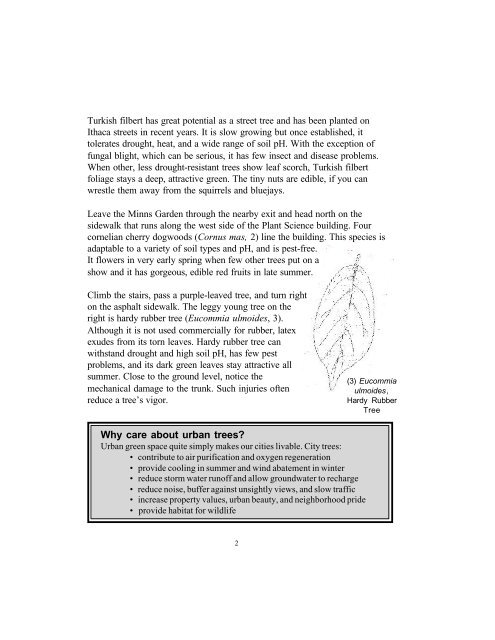Recommended Urban Trees: A Cornell Campus Walk - Horticulture ...
Recommended Urban Trees: A Cornell Campus Walk - Horticulture ...
Recommended Urban Trees: A Cornell Campus Walk - Horticulture ...
Create successful ePaper yourself
Turn your PDF publications into a flip-book with our unique Google optimized e-Paper software.
Turkish filbert has great potential as a street tree and has been planted on<br />
Ithaca streets in recent years. It is slow growing but once established, it<br />
tolerates drought, heat, and a wide range of soil pH. With the exception of<br />
fungal blight, which can be serious, it has few insect and disease problems.<br />
When other, less drought-resistant trees show leaf scorch, Turkish filbert<br />
foliage stays a deep, attractive green. The tiny nuts are edible, if you can<br />
wrestle them away from the squirrels and bluejays.<br />
Leave the Minns Garden through the nearby exit and head north on the<br />
sidewalk that runs along the west side of the Plant Science building. Four<br />
cornelian cherry dogwoods (Cornus mas, 2) line the building. This species is<br />
adaptable to a variety of soil types and pH, and is pest-free.<br />
It flowers in very early spring when few other trees put on a<br />
show and it has gorgeous, edible red fruits in late summer.<br />
Climb the stairs, pass a purple-leaved tree, and turn right<br />
on the asphalt sidewalk. The leggy young tree on the<br />
right is hardy rubber tree (Eucommia ulmoides, 3).<br />
Although it is not used commercially for rubber, latex<br />
exudes from its torn leaves. Hardy rubber tree can<br />
withstand drought and high soil pH, has few pest<br />
problems, and its dark green leaves stay attractive all<br />
summer. Close to the ground level, notice the<br />
mechanical damage to the trunk. Such injuries often<br />
reduce a tree’s vigor.<br />
Why care about urban trees?<br />
<strong>Urban</strong> green space quite simply makes our cities livable. City trees:<br />
• contribute to air purification and oxygen regeneration<br />
• provide cooling in summer and wind abatement in winter<br />
• reduce storm water runoff and allow groundwater to recharge<br />
• reduce noise, buffer against unsightly views, and slow traffic<br />
• increase property values, urban beauty, and neighborhood pride<br />
• provide habitat for wildlife<br />
2<br />
(3) Eucommia<br />
ulmoides,<br />
Hardy Rubber<br />
Tree

















